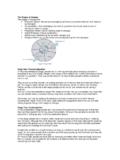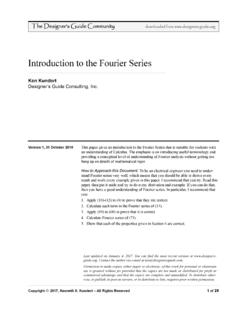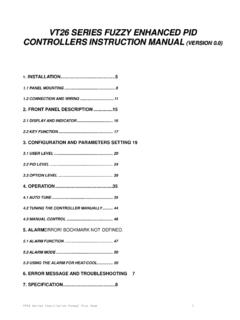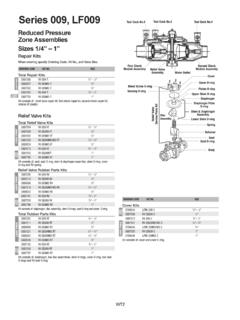Transcription of The Stages of Change - Virginia Tech
1 The Stages of Change The Stages of Change are: Precontemplation (Not yet acknowledging that there is a problem behavior that needs to be changed) Contemplation (Acknowledging that there is a problem but not yet ready or sure of wanting to make a Change ) Preparation/Determination (Getting ready to Change ) Action/Willpower (Changing behavior) Maintenance (Maintaining the behavior Change ) and Relapse (Returning to older behaviors and abandoning the new changes) stage One: Precontemplation In the precontemplation stage , people are not thinking seriously about changing and are not interested in any kind of help. People in this stage tend to defend their current bad habit(s) and do not feel it is a problem. They may be defensive in the face of other people s efforts to pressure them to quit. They do not focus their attention on quitting and tend not to discuss their bad habit with others. In AA, this stage is called denial, but at Addiction Alternatives, we do not like to use that term.
2 Rather, we like to think that in this stage people just do not yet see themselves as having a problem. Are you in the precontemplation stage ? No, because the fact that you are reading this shows that you are already ready to consider that you may have a problem with one or more bad habits. (Of course, you may be reading this because you have a loved one who is still in the pre-contemplation stage . If this is the case, keep reading for suggestions about how you can help others progress through their Stages of Change ) stage Two: Contemplation In the contemplation stage people are more aware of the personal consequences of their bad habit and they spend time thinking about their problem. Although they are able to consider the possibility of changing, they tend to be ambivalent about it. In this stage , people are on a teeter-totter, weighing the pros and cons of quitting or modifying their behavior. Although they think about the negative aspects of their bad habit and the positives associated with giving it up (or reducing), they may doubt that the long-term benefits associated with quitting will outweigh the short-term costs.
3 It might take as little as a couple weeks or as long as a lifetime to get through the contemplation stage . (In fact, some people think and think and think about giving up their bad habit and may die never having gotten beyond this stage ) On the plus side, people are more open to receiving information about their bad habit, and more likely to actually use educational interventions and reflect on their own feelings and thoughts concerning their bad habit. stage Three: Preparation/Determination In the preparation/determination stage , people have made a commitment to make a Change . Their motivation for changing is reflected by statements such as: I ve got to do something about this this is serious. Something has to Change . What can I do? This is sort of a research phase: people are now taking small steps toward cessation. They are trying to gather information (sometimes by reading things like this) about what they will need to do to Change their behavior. Or they will call a lot of clinics, trying to find out what strategies and resources are available to help them in their attempt.
4 Too often, people skip this stage : they try to move directly from contemplation into action and fall flat on their faces because they haven t adequately researched or accepted what it is going to take to make this major lifestyle Change . stage Four: Action/Willpower This is the stage where people believe they have the ability to Change their behavior and are actively involved in taking steps to Change their bad behavior by using a variety of different techniques. This is the shortest of all the Stages . The amount of time people spend in action varies. It generally lasts about 6 months, but it can literally be as short as one hour! This is a stage when people most depend on their own willpower. They are making overt efforts to quit or Change the behavior and are at greatest risk for relapse. Mentally, they review their commitment to themselves and develop plans to deal with both personal and external pressures that may lead to slips. They may use short-term rewards to sustain their motivation, and analyze their behavior Change efforts in a way that enhances their self-confidence.
5 People in this stage also tend to be open to receiving help and are also likely to seek support from others (a very important element). Hopefully, people will then move to: stage Five: Maintenance Maintenance involves being able to successfully avoid any temptations to return to the bad habit. The goal of the maintenance stage is to maintain the new status quo. People in this stage tend to remind themselves of how much progress they have made. People in maintenance constantly reformulate the rules of their lives and are acquiring new skills to deal with life and avoid relapse. They are able to anticipate the situations in which a relapse could occur and prepare coping strategies in advance. They remain aware that what they are striving for is personally worthwhile and meaningful. They are patient with themselves and recognize that it often takes a while to let go of old behavior patterns and practice new ones until they are second nature to them. Even though they may have thoughts of returning to their old bad habits, they resist the temptation and stay on track.
6 As you progress through your own Stages of Change , it can be helpful to re-evaluate your progress in moving up and down through these Stages . (Even in the course of one day, you may go through several different Stages of Change ). And remember: it is normal and natural to regress, to attain one stage only to fall back to a previous stage . This is just a normal part of making changes in your behavior. stage of Change Characteristics Techniques Pre-contemplation Not currently considering Change : "Ignorance is bliss" Validate lack of readiness. Clarify: decision is theirs Encourage re-evaluation of current behavior Encourage self-exploration, not action Explain and personalize the risk Contemplation Ambivalent about Change : "Sitting on the fence" Not considering Change within the next month Validate lack of readiness Clarify: decision is theirs Encourage evaluation of pros and cons of behavior Change Identify and promote new, positive outcome expectations Preparation Some experience with Change and are trying to Change : "Testing the waters" Planning to act within 1month Identify and assist in problem solving re.
7 Obstacles Help patient identify social support Verify that patient has underlying skills for behavior Change Encourage small initial steps Action Practicing new behavior for 3-6 months Focus on restructuring cues and social support Bolster self-efficacy for dealing with obstacles Combat feelings of loss and reiterate long-term benefits Maintenance Continued commitment to sustaining new behavior Post-6 months to 5 years Plan for follow-up support Reinforce internal rewards Discuss coping with relapse Relapse Resumption of old behaviors: "Fall from grace" Evaluate trigger for relapse Reassess motivation and barriers Plan stronger coping strategies The transtheoretical model (TTM) of Change in health psychology explains or predicts a person's success or failure in achieving a proposed behavior Change , such as developing different habits. It attempts to answer why the Change "stuck" or alternatively why the Change was not made. The transtheoretical model (TTM) currently, the most popular stage model in health psychology (Horwath, 1999) has proven successful with a wide variety of simple and complex health behaviors, including smoking cessation, weight control, sunscreen use, reduction of dietary fat, exercise acquisition, quitting cocaine, mammography screening, and condom use (Prochaska, et al.)
8 , 1994). Based on more than 15 years of research, the TTM has found that individuals move through a series of five Stages (precontemplation, contemplation, preparation, action, maintenance) in the adoption of healthy behaviors or cessation of unhealthy ones. TTM research on a variety of different problem behaviors has also shown that there are certain predictors of progression through the Stages of Change ( , Prochaska & DiClemente, 1983), including decisional balance (Prochaska, 1994); self-efficacy ( , DiClemente, Prochaska, & Gibertini, 1985); and the processes of Change (Prochaska & DiClemente, 1983). The Stages of Change The TTM (for review, see Prochaska & Velicer, 1997) explains intentional behavior Change along a temporal dimension that utilizes both cognitive and performance-based components. Based on more than two decades of research, the TTM has found that individuals move through a series of Stages precontemplation (PC), contemplation (C), preparation (PR), action (A), and maintenance (M) in the adoption of healthy behaviors or cessation of unhealthy ones (Prochaska & Velicer, 1997).
9 Pre-Contemplation is the stage in which an individual has no intent to Change behavior in the near future, usually measured as the next 6 months. Precontemplators are often characterized as resistant or unmotivated and tend to avoid information, discussion, or thought with regard to the targeted health behavior (Prochaska et al., 1992). Contemplation stage . Individuals in this stage openly state their intent to Change within the next 6 months. They are more aware of the benefits of changing, but remain keenly aware of the costs (Prochaska, Redding, & Evers, 1997). Contemplators are often seen as ambivalent to Change or as procrastinators (Prochaska & DiClemente, 1984). Preparation is the stage in which individuals intend to take steps to Change , usually within the next month (DiClemente et al., 1991). PR is viewed as a transition rather than stable stage , with individuals intending progress to A in the next 30 days (Grimley, Prochaska, Velicer, Blais, & DiClemente, 1994).
10 Action stage is one in which an individual has made overt, perceptible lifestyle modifications for fewer than 6 months (Prochaska et al., 1997). Maintenance: these are working to prevent relapse and consolidate gains secured during A (Prochaska et al., 1992). Maintainers are distinguishable from those in the A stage in that they report the highest levels of self-efficacy and are less frequently tempted to relapse (Prochaska & DiClemente, 1984). The TTM uses the Stages of Change to integrate cognitive and behavioral processes and principles of Change , including 10 processes of Change ( , how one changes; Prochaska, 1979; Prochaska, Velicer, DiClemente, & Fava, 1988), pros and cons ( , the benefits and costs of changing; Janis & Mann, 1977; Prochaska, Redding, Harlow, Rossi, & Velicer, 1994; Prochaska, Velicer, et al., 1994), and self-efficacy ( , confidence in one s ability to Change ; Bandura,1977; DiClemente, Prochaska, & Gibertini, 1985) all of which have demonstrated reliability and consistency in describing and predicting movement through the Stages (Prochaska & Velicer, 1997).






